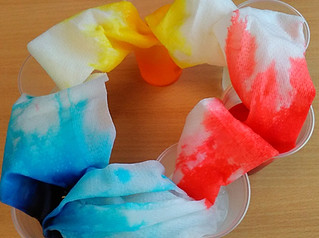



Our Lady of the Wayside N.S. Ballybetagh Road
Kilternan
Dublin
D18 CY28


Materials

Frankenworms
Materials > Materials and Change
2nd class Ms O'Doherty, Junior Infants, Ms Donnelly
Felt Making
Materials > Properties asnd Characteristics
1st class, Ms Martin
Rainbow Art
Materials > Materials and Change
1st class, Ms Martin
Invisible Ink and Berry Ink
Materials > Materials and Change
6th class, Ms Galavan
Butter Making
Materials > Materials and Change
2nd class, Ms Donnelly
Forensic Science Day
Materials > Materials and Change
5th class, Ms Grier-Gavin
Colour Rainbow
Materials > Materials and Change
2nd class, Ms O'Doherty
Second class and junior infants completed their science investigation with Frankenworms. They placed some jelly worms into a mixture of baking soda and water for 15 minutes. The soaked worms were then taken out of the mixture and placed into a glass of vinegar. The baking soda in the worms reacted with the vinegar and gave off carbon dioxide gas which bubbled up through the vinegar and caused the worms to wriggle.
Children used felt making techniques to create pictures of their own from felt! This involved the children selecting lots of thin pieces of felt and creating a picture. Next the children added warm soapy water to the felt and applied lots and lots of friction (using their hands). This action caused all of the separate strips of felt to bond together to form one single unit.
Through this process the children explored the characteristics of felt when wet and dry. They also discovered how felt bonded when friction and warm soapy water were applied.
The children in First Class learned how to make lots of different colours by using only red, blue, yellow paints! They learned that by mixing red and yellow - they got orange, by adding blue to yellow - they made green, and by mixing blue and red together they made purple!
Through this fun process the children were able to investigate how materials may be changed by mixing. Their end pieces resulted in beautiful coloured paintings incorporating all the colours of the rainbow!
We were learning about the farm and farm animals. We learned that you get milk from cows and we were learning about the different products that can be made from milk. We decided to make our own butter using cream. We began by shaking a container of cream for 10 - 15 minutes. We then separated the contents into buttermilk and butter. The buttermilk could be used in baking. We spread our butter on some bread and it tasted delicious!



















As part of History we were studying Early Christian Ireland. We learned that monks wrote manuscripts using ink that they made themselves from plants and berries. We made our own ink by sieving raspberries. We added ½ teaspoon of vinegar to hold the colour and ½ teaspoon of salt which acted as a preservative. We mixed all together well and used sticks we gathered in the yard to write messages. It was long and hard work!
We then had fun making invisible ink. We used lemon juice and water to write messages. We held the page over a toaster and the message was revealed. We wrote our names in the invisible ink and then covered the page with baking soda. The baking soda combined with the lemon juice to display the name.
Forensic Day 14th November 2018
Class: 5th Class Ms. Grier-Gavin
Subject: Science
Strand: Materials
Strand Unit(s):
-
Properties and characteristics of materials
-
Materials and change
On 14th November 2018, Fifth class were invited to participate in a Crime Scene Investigation. We worked in teams to solve the crime. We learned about common forensic science strategies such as examining biological evidence, print evidence and footwear evidence. By using our knowledge of these forensic science techniques we were able to solve the crime!












We mixed primary colours to form secondary colours using this water property. Colured water from each cup moved up through the tissue paper and mixed with another colour when they met. This happens because of capillary action.







